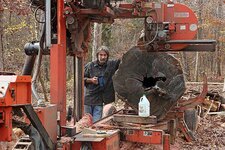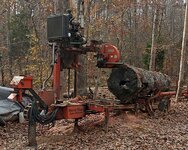My bandsaw has about 4.5 inches of clearance and I have logs that are upwards of 8-10 inches. This does not include the trunk sections but that can be taken care of with a chainsaw.
I am looking for alternatives to rip the smaller logs down into planks and blanks. If I have to use the chainsaw I will but there is a lot of lost wood. I want as much usable lumber as I can get. I have already asked everyone I know who has a bandsaw and they have the same clearance issues. I am going to try a friend's table saw to see if that will work, but I am sure it will only work on those that are in the 5-8 inch range.
Any other thoughts?
If I understand correctly, you want to rip logs and not slice them, right...???, Slicing means that you would be cutting end grain circles (log diameter), ripping you would be cutting the log on its length and with the grain.
For slicing logs, unless you have a decent jig made up, the very first thing that will happen is the blade teeth get caught in the wood, rotating and twisting the log off you hand and, braking the blade or damage it so bad that is becomes unusable...!
With the bandsaw ripping, and while jigs can make the cuts a little straighter and a little easier, unless the bandsaw opening is not sufficient to rip the log through the middle (pith) and then work the 2 halves a lot easier, you either have to rip it with the bandsaw and you may just have enough hight on the bandsaw to rip the log halves then.
The starting of the log "squaring" is a lot safer and easier if you start by ripping the log in half, if you want to cut the 2 round edges of the log to get a flat surface to start with, I always prefer to use a sharp blade with not very "aggressive" teeth like the 1 or 2 TPI (in such small size bandsaw you have, they wouldn't be recommended, anyway...!) and the fence as a guide against the round edge to be removed first.
Never the other way around as you need to have something to hold on too, (push the log through the blade), so the bigger part of the log is on you right (well, unless you have the fence set up on the right of the bandsaw, which is uncommon...!)
If you feel a little "uncomfortable" or not experienced enough to do this, the next step is to set up everything the way I mention above but this time, and with the bandsaw turned off, you bring the correct side of the log against the fence and using the fence as a ruler get a pen/marker and make a long mark/line or one on each end of the log.
You now get a straight strip of wood 1 1/2 x 1 1/2 is normally enough, depending of the fence hight, and nail or screw it to the log, above the line/mark you just made, making sure that, what ever you are fastening/securing the wood strip to the log is not going to be caught by the blade, for that, a simple adjustment of the fence will create sufficient gap to cut the logs round edge and miss the metal...! It makes a lot of sense to make this strip of wood, twice as long as the log and securing with even lengths on both ends of the log.
As soon as you have one side of the log square, you can repeat the process for the nest edge or if the log is too irregular, try to mark a line manually on the side/edge you want to remove/cut and pushing the fence away, you simply guide manually the log on that line through the blade, and complete your log squaring (90°).
Now, a bandsaw with such small opening, has many other limitation also, the motor strength/torque to start with and the type of blades you can use on them. The whole bandsaw structure is not made for pushing very dense woods or logs of certain sizes, exactly the type of stuff you are trying to do so, I will strongly suggest that you find someone with a big(ger) bandsaw and with enough experience to rip this logs for you, at least to sizes that you can manage OK with what you've got at home.
It goes without saying that, whatever you decided to do on/with your bandsaw, please be careful, think to where your hands will need to go before you start the cut, and if you feel that is just too much of a risk for you to try something and back off of it, is a very good chance that you just voided a bad accident...!:wink:
Best of luck
Cheers
George


